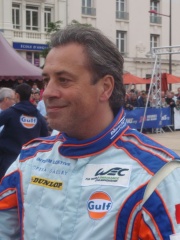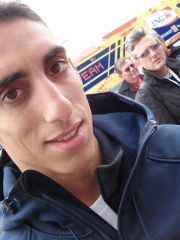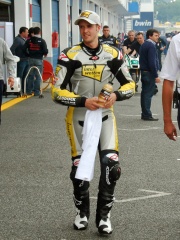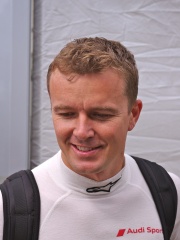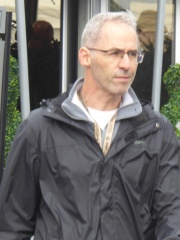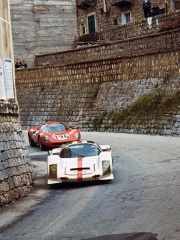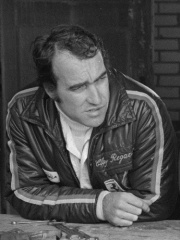
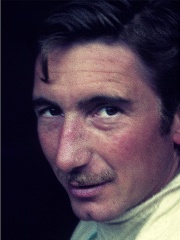
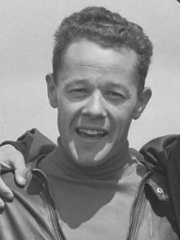
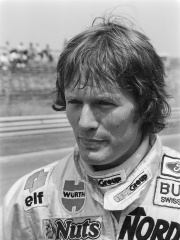
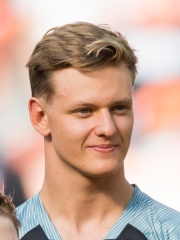
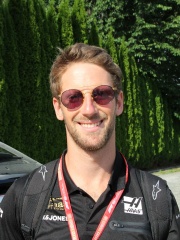


The Most Famous
RACING DRIVERS from Switzerland
This page contains a list of the greatest Swiss Racing Drivers. The pantheon dataset contains 1,080 Racing Drivers, 31 of which were born in Switzerland. This makes Switzerland the birth place of the 9th most number of Racing Drivers behind Brazil, and Japan.
Top 10
The following people are considered by Pantheon to be the top 10 most legendary Swiss Racing Drivers of all time. This list of famous Swiss Racing Drivers is sorted by HPI (Historical Popularity Index), a metric that aggregates information on a biography's online popularity. Visit the rankings page to view the entire list of Swiss Racing Drivers.

1. Clay Regazzoni (1939 - 2006)
With an HPI of 70.48, Clay Regazzoni is the most famous Swiss Racing Driver. His biography has been translated into 32 different languages on wikipedia.
Gianclaudio Giuseppe "Clay" Regazzoni (Italian pronunciation: [dʒaŋˈklaudjo dʒuˈzɛppe reɡatˈtsoːni]; 5 September 1939 – 15 December 2006) was a Swiss racing driver and broadcaster, who competed in Formula One from 1970 to 1980. Regazzoni was runner-up in the Formula One World Drivers' Championship in 1974 with Ferrari, and won five Grands Prix across 11 seasons. His first win was the Italian Grand Prix at Monza in his debut season, driving for Ferrari. He remained with the Italian team until 1972. After a single season with BRM, Regazzoni returned to Ferrari for a further three years from 1974 (where he was the runner-up to Emerson Fittipaldi) to 1976. After finally leaving Ferrari at the end of 1976, Regazzoni joined the Ensign and Shadow teams, before moving to Williams in 1979, where he took the British team's first ever Grand Prix victory, the 1979 British Grand Prix at Silverstone. Regazzoni was replaced by Carlos Reutemann at Williams for 1980 and moved back to Ensign. Following an accident at the 1980 United States Grand Prix West, he was left paralyzed from the waist down, ending his career in Formula One. Regazzoni did not stop racing, and he competed in the Paris–Dakar rally and Sebring 12 Hours using a hand-controlled car during the late 1980s and early 1990s. In 1996, Regazzoni became a commentator for Italian TV. He was known as a hard-charging racer, sometimes inconsequential. Jody Scheckter stated that if "he'd been a cowboy he'd have been the one in the black hat". Regazzoni died in a car accident in Italy on 15 December 2006.

2. Jo Siffert (1936 - 1971)
With an HPI of 63.91, Jo Siffert is the 2nd most famous Swiss Racing Driver. His biography has been translated into 22 different languages.
Joseph "Jo" Siffert (French pronunciation: [ʒo(zɛf) sifɛʁ]; 7 July 1936 – 24 October 1971) was a Swiss racing driver, who competed in Formula One from 1962 to 1971. Siffert won two Formula One Grands Prix across 10 seasons. Affectionately known as "Seppi" to his family and friends, Siffert was born in Fribourg, the son of a dairy owner. He initially made his name in racing on two wheels, winning the Swiss 350 cc motorcycle championship in 1959, before switching to four wheels with a Formula Junior Stanguellini. Siffert graduated to Formula One as a privateer in 1962, with a four-cylinder Lotus-Climax. He later moved to Swiss team Scuderia Filipinetti, and in 1964 joined Rob Walker's private British Rob Walker Racing Team. Early successes included victories in the 1964 and 1965 Mediterranean Grands Prix non-Championship Formula One races, both times beating Jim Clark by a very narrow margin. He won two World Championship races, one for the Rob Walker Racing Team and one for BRM. He died at the 1971 World Championship Victory Race, a non-Championship Formula One race, having his car roll over after a crash caused by a mechanical failure and being caught under the burning vehicle. Siffert was married twice and to his second wife Simone during the height of his career in the late 1960s and at the time of his death. They had two children together, Véronique and Philippe.

3. Luigi Taveri (1929 - 2018)
With an HPI of 60.61, Luigi Taveri is the 3rd most famous Swiss Racing Driver. His biography has been translated into 19 different languages.
Luigi Taveri (19 September 1929 – 1 March 2018) was a Swiss professional Grand Prix motorcycle road racer. He competed in the FIM motorcycle Grand Prix world championships from 1954 to 1966. Taveri is notable for being a three-time 125cc road racing world champion. Although he specialised in the smaller engined machines, Taveri is the only competitor to have scored points in six Grand Prix classes: 50cc, 125cc, 250cc, 350cc, 500cc and Sidecars. In 2016, he was named an FIM Legend for his motorcycling achievements.

4. Marc Surer (b. 1951)
With an HPI of 60.26, Marc Surer is the 4th most famous Swiss Racing Driver. His biography has been translated into 24 different languages.
Marc Surer (born 18 September 1951) is a Swiss former racing driver and broadcaster, who competed in Formula One from 1979 to 1986. Born in Arisdorf, Surer began kart racing aged 20. He moved to Germany in 1974 to compete in Formula Vee, as motor racing was banned in Switzerland following the 1955 Le Mans disaster. After finishing runner-up in the 1976 German Formula Three Championship, Surer progressed to European Formula Two, winning the title in 1979 with the BMW Junior Team. Making his Formula One debut at the Italian Grand Prix that year with Ensign, Surer signed for ATS in 1980. He participated in 88 Formula One Grands Prix, scoring 17 championship points.
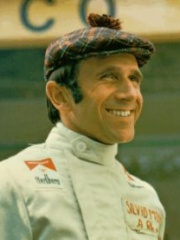
5. Silvio Moser (1941 - 1974)
With an HPI of 59.89, Silvio Moser is the 5th most famous Swiss Racing Driver. His biography has been translated into 24 different languages.
Silvio Moser (24 April 1941 – 26 May 1974) was a racing driver from Switzerland.

6. Mick Schumacher (b. 1999)
With an HPI of 58.28, Mick Schumacher is the 6th most famous Swiss Racing Driver. His biography has been translated into 47 different languages.
Mick Schumacher (German pronunciation: [ˈmɪk ˈʃuːmaxɐ]; born 22 March 1999) is a German racing driver, who competes in the IndyCar Series driving the No. 47 Dallara-Honda for Rahal Letterman Lanigan Racing. Schumacher competed in Formula One from 2021 to 2022, and the FIA WEC from 2024 to 2025. Born and raised in Switzerland, Schumacher is the son of seven-time Formula One World Drivers' Champion Michael Schumacher and equestrian Corinna Betsch, as well as the nephew of former Formula One driver Ralf and the cousin of sportscar racing driver David. Initially competing under the pseudonyms Mick Betsch and Mick Junior, Schumacher finished runner-up to Enaam Ahmed at the junior direct-drive Karting World Championship and Karting European Championship in 2014. Graduating to junior formulae in 2015, Schumacher finished runner-up in both ADAC F4 and Italian F4 the next year. After finishing third in the MRF Challenge Championship, Schumacher moved to FIA European Formula 3, winning the championship with Prema the following season. Progressing to FIA Formula 2 for 2019, Schumacher won the title in his 2020 campaign with Prema. A member of the Ferrari Driver Academy since 2019, Schumacher was a test driver for Alfa Romeo and Haas in 2020, before signing with the latter as a full-time driver in 2021. Making his Formula One debut at the Bahrain Grand Prix alongside Nikita Mazepin, Haas failed to score points all season with the VF-21, with Schumacher finishing a season-best twelfth in Hungary. Retaining his seat to partner Kevin Magnussen for 2022, Schumacher scored his maiden points finish at the British Grand Prix, followed by a career-best sixth at the Austrian Grand Prix. After a series of high-profile crashes, Schumacher was released by Haas at the end of the season, returning as a reserve driver for both Mercedes and McLaren in 2023; he left both positions in 2024. Schumacher moved to the FIA World Endurance Championship in 2024 with Alpine, achieving his maiden podium finish at the 6 Hours of Fuji. He achieved further podiums at the 6 Hours of Imola and Spa-Francorchamps in 2025.

7. Romain Grosjean (b. 1986)
With an HPI of 57.41, Romain Grosjean is the 7th most famous Swiss Racing Driver. His biography has been translated into 50 different languages.
Romain David Jeremie Grosjean (French pronunciation: [ʁɔmɛ̃ ɡʁoʒɑ̃]; born 17 April 1986) is a French and Swiss racing driver, who competes in the IMSA SportsCar Championship for Lamborghini and serves as a reserve driver in the IndyCar Series for Prema. Grosjean competed under the French flag in Formula One between 2009 and 2020, and the IndyCar Series from 2021 to 2024. Born and raised in Geneva to a Swiss father and French mother, Grosjean is the grandson of Olympic alpine skier Fernand Grosjean and the great-grandson of weapons designer Edgar Brandt. Graduating from kart racing to junior formulae in 2003 under a Swiss license, Grosjean began his career in Formula LO before moving to French Formula Renault in 2004 with SG Formula. He dominated the following season with 10 wins from 16 races. He then progressed to the Formula 3 Euro Series, winning the championship in 2007 amidst a title battle with Sébastien Buemi. Grosjean graduated to the GP2 Series in 2008, finishing fourth in his rookie season and winning the Asia Series. A member of the Renault Sport Academy since 2006, Grosjean debuted in Formula One with Renault at the 2009 European Grand Prix, replacing Nelson Piquet Jr. for the remainder of the 2009 season. He returned to junior formulae in 2010, winning the Auto GP Series, as well as becoming a race-winner in FIA GT1. He then won the GP2 title in 2011, as well as another Asia Series. In 2012, Grosjean returned to Formula One with Lotus alongside Kimi Räikkönen. He took his maiden podium finish at the Bahrain Grand Prix, repeating this feat in Canada and Hungary. Grosjean became the first driver to receive a race ban in eighteen years after causing a multi-car collision at the Belgian Grand Prix. He achieved six further podiums in 2013 as he finished a career-best seventh in the World Drivers' Championship. Partnered by Pastor Maldonado in 2014 and 2015, he achieved his final podium at the latter Belgian Grand Prix. Grosjean moved to Haas for his 2016 campaign, ending his ten-year association with Team Enstone. He scored several points finishes in his 2017, 2018 and 2019 campaigns alongside Kevin Magnussen, finishing fourth at the 2018 Austrian Grand Prix. In 2020, Grosjean survived a crash during the opening lap of the Bahrain Grand Prix—his final race in Formula One—when his VF-20 split and caught fire after penetrating a metal crash barrier; he sustained second-degree burns and credited the halo device with saving his life. Grosjean moved to the IndyCar Series in 2021 with Dale Coyne, achieving his maiden pole position and podium at the Grand Prix of Indianapolis. He scored several further podiums across the 2022 and 2023 seasons with Andretti. After contesting 2024 with Juncos Hollinger, Grosjean moved to sportscar racing with Lamborghini in the IMSA SportsCar Championship.

8. Heinz Schiller (1930 - 2007)
With an HPI of 55.27, Heinz Schiller is the 8th most famous Swiss Racing Driver. His biography has been translated into 18 different languages.
Heinz Rudolf Schiller (Frauenfeld, Switzerland, January 25, 1930 – Montana, Switzerland, March 26, 2007), was a racing driver from Switzerland. He participated in one Formula One World Championship Grand Prix, on August 5, 1962. He retired from the race, scoring no championship points. Schiller was a speedboat champion in his native Switzerland before turning to sports car racing, finding success during the mid-1950s. He then switched to single seater cars, starting in hillclimbing before moving up to circuit racing. He first appeared in Formula One at the beginning of 1962 with Ecurie Nationale Suisse, driving their three-year-old Porsche in the Brussels Grand Prix, where he finished 8th on aggregate after the three heats. He subsequently drove the same car at the 1962 Pau Grand Prix, coming home 9th. Under the Ecurie Filipinetti banner but still driving the same Porsche, Schiller failed to qualify at the Naples Grand Prix, largely because only 10 cars were permitted to take the start. He was entered by Ecurie Maarsbergen for the 1962 Belgian Grand Prix but was withdrawn, before finishing 7th in the Grosser Preis der Solitude for Ecurie Filipinetti. He then switched to a Lotus 24 for his single World Championship event, the 1962 German Grand Prix which ended with oil pressure problems, as did his attempt at the Mediterranean Grand Prix, now back in the Porsche. Schiller made one appearance in Formula One in 1963, finishing 3rd at Pau but five laps down, again in the old Porsche, before returning to sports cars. He finished 10th at the 1964 24 Hours of Le Mans with Gerhard Koch.

9. Max de Terra (1918 - 1982)
With an HPI of 55.13, Max de Terra is the 9th most famous Swiss Racing Driver. Her biography has been translated into 19 different languages.
Max de Terra (6 October 1918 – 29 December 1982) was a Swiss racing driver. He participated in two Formula One World Championship Grands Prix, debuting on 18 May 1952. He scored no championship points. He was a member of the Ecurie Espadon.
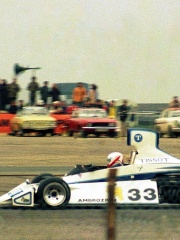
10. Loris Kessel (1950 - 2010)
With an HPI of 55.03, Loris Kessel is the 10th most famous Swiss Racing Driver. His biography has been translated into 21 different languages.
Loris Kessel (1 April 1950 – 15 May 2010) was a racing driver from Switzerland.
People
Pantheon has 31 people classified as Swiss racing drivers born between 1908 and 1999. Of these 31, 19 (61.29%) of them are still alive today. The most famous living Swiss racing drivers include Marc Surer, Mick Schumacher, and Romain Grosjean. The most famous deceased Swiss racing drivers include Clay Regazzoni, Jo Siffert, and Luigi Taveri.
Living Swiss Racing Drivers
Go to all RankingsMarc Surer
1951 - Present
HPI: 60.26
Mick Schumacher
1999 - Present
HPI: 58.28
Romain Grosjean
1986 - Present
HPI: 57.41
Jo Vonlanthen
1942 - Present
HPI: 54.64
Jean-Denis Délétraz
1963 - Present
HPI: 54.55
Sébastien Buemi
1988 - Present
HPI: 53.21
Franco Forini
1958 - Present
HPI: 51.81
Jean-Claude Rudaz
1942 - Present
HPI: 50.95
Gregor Foitek
1965 - Present
HPI: 50.83
Thomas Lüthi
1986 - Present
HPI: 45.39
Marcel Fässler
1976 - Present
HPI: 45.27
Alain Menu
1963 - Present
HPI: 44.54
Deceased Swiss Racing Drivers
Go to all RankingsClay Regazzoni
1939 - 2006
HPI: 70.48
Jo Siffert
1936 - 1971
HPI: 63.91
Luigi Taveri
1929 - 2018
HPI: 60.61
Silvio Moser
1941 - 1974
HPI: 59.89
Heinz Schiller
1930 - 2007
HPI: 55.27
Max de Terra
1918 - 1982
HPI: 55.13
Loris Kessel
1950 - 2010
HPI: 55.03
Toni Branca
1916 - 1985
HPI: 54.74
Ottorino Volonterio
1917 - 2003
HPI: 54.34
Heini Walter
1927 - 2009
HPI: 54.24
Albert Scherrer
1908 - 1986
HPI: 53.72
Peter Hirt
1910 - 1992
HPI: 53.16
Overlapping Lives
Which Racing Drivers were alive at the same time? This visualization shows the lifespans of the 12 most globally memorable Racing Drivers since 1700.


